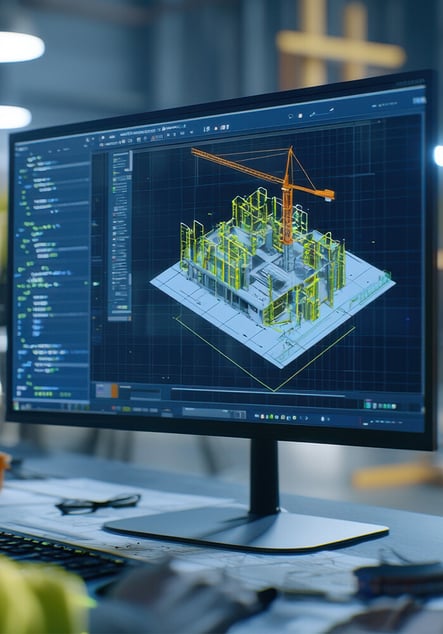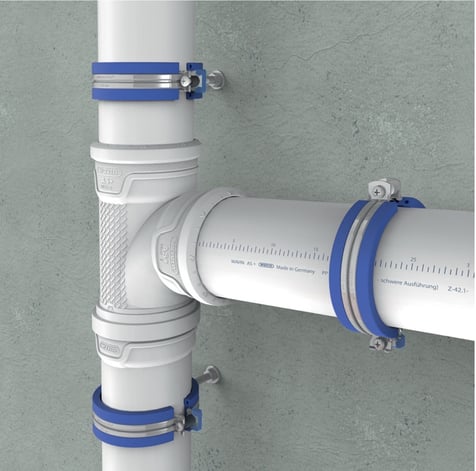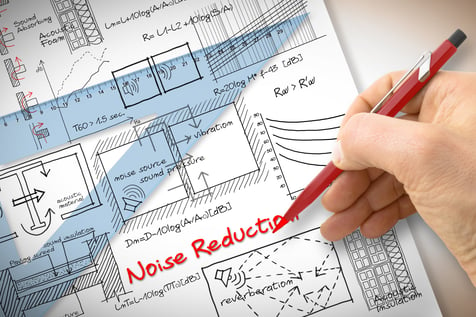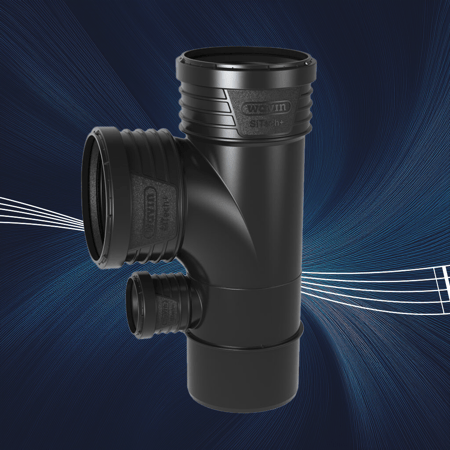Master the Symphony of Silence with Wavin
As the first company to introduce a full plastic based low-noise drainage system, we understand the complexity and societal importance of soundproofing in buildings. Silence is layered. You need to orchestrate every element to create absolute stillness. With Wavin’s Low Noise Drainage System, you become the conductor of this symphony. Control each component, mix and match solutions and create the best-balanced performance budget tailored-fit installation for every project. Don’t just reduce noise—master the symphony of silence with Wavin! Need expert guidance for your soil and waste drainage projects? Request a free technical consultation today!




Discover How You Can Master The Symphony of Silence In Every Project
With expert knowledge, high-quality products, and innovative tools at your disposal, achieving optimal sound control has never been easier.
✓ Expert consultation to guide you toward the perfect solution for your specific needs.
✓ Cost-effective solutions with the flexibility to mix and match components seamlessly.
✓ Tailored-fit options designed to meet the unique requirements of every project.
✓ Superior performance and reliability to ensure lasting results and satisfaction.
Experience the difference that precision and expertise can bring to your projects.

All the Low Noise Drainage Expertise You Need - In One Place
As a long-standing leader in technical drainage installation sound insulation, we are your trusted experts, partners, and innovators. Whether you're working on renovation projects or new builds, from residential complexes to commercial spaces, we provide solutions tailored to meet your acoustic needs. Our expertise extends to hotels, hospitals, nursing homes, office buildings, and high-rise developments, where noise control is essential for comfort and well-being.
Our Acoustic Sound Competence Brochure offers a complete A-to-Z guide on sound insulation in construction. From understanding sound formation to exploring measurement methods and industry standards, we provide everything you need to create quieter, more comfortable environments.
Download our brochure today and master the symphony of silence in every project you undertake.
Our Products And Solutions
-
.png?width=600&height=450&name=Wavin%20AS+%20elbow%20(005).png)
Wavin AS+
ultimate noise reduction
Wavin AS+ gives you unparalleled sound insulation and superior performance in mechanical installations. -

Wavin SiTech+ noise-reducing pipe system
With its easy installation and ribbed design, SiTech+ gives you unmatched value for your investment. -

Mix and Match solutions
Wavin AS+ and Wavin SiTech+ can be seamlessly combined to meet specific project requirements.
Frequently Asked Questions
What is a low-noise pipe and why is there a need for low-noise pipe systems in wastewater drainage?
A low-noise pipe — also commonly referred to as a silent pipe, acoustic pipe, soundproofing pipe, or soundproof pipe — is a drainage pipe that is specifically designed to reduce noise emissions. Low-noise pipes are usually produced using materials that minimise vibrations and the propagation of sound waves. They are a key component of effective sound insulation in all types of buildings.
In general, low-noise pipes help to create low-noise environments, which improve the comfort, health, and well-being of occupants in any building. In such environments, people can sleep better, and focus better on their work.
Low-noise pipe systems are crucial for achieving a better living experience. On a regulatory level, certain buildings such as public buildings, hotels, and hospitals must fulfil local noise regulation standards according to EN or DIN norms. If noise levels are not reduced to the agreed standards, there can be legal consequences.
What are the differences between structure-borne and air-borne sounds?
The difference between structure-borne and air-borne sound lies in the propagation of the sound. Structure-borne sound is generated by physical impacts or vibrations that travel through a building’s floors, walls, ceilings and other structures. Whereas air-borne sound does not depend on a building’s physical structure to travel, and is instead propagated directly through the air.
Usually, structure-borne sound can be heard over a longer distance compared to air-borne sound.
Why is it the case, in sound calculations, that 1+1 does not equal 2
In sound calculations, the result often deviates from conventional expectations. This is because we cannot apply standard calculation methods to sound, which are invisible waves in the air, transformed into nerve signals in our ears and interpreted by the brain. If two sound sources with the same sound pressure are emitted simultaneously in the same place, the perceived sound pressure will be 3 dB(A) higher.
60 dB(A) + 60 dB(A) = 63 dB(A)
How is sound perceived by a human ear?
The human ear is able to perceive a wide spectrum of sounds, from the fragile sound of a pin hitting the floor to the rumbling noise of a jet plane. Below 40dB(A) small sound variations of 3dB(A) are perceived as a doubling of the loudness. Above 40dB(A) raising of the sound level of 10dB(A) has the same effect of doubling or halving of the loudness.
The piping systems is optimized to dampen the sound pressure level that are most sensitive for the human ear to create an optimum working or living environment.
What is the Fraunhofer IBP report and how does it measure the noise
The Fraunhofer Institute publishes various IBP reports which present findings and insights related to building acoustics, noise control, and sound insulation. These reports are helpful for architects, planners, engineers, and industry stakeholders looking to address noise-related challenges in building design and construction.
To measure noise, the institute uses systems such as field measurements, laboratory testing, and computer simulations, to test how much sound is emitted through building walls.
Noise measurements are performed in the test environment at the Fraunhofer IBP institute in Stuttgart, Germany, on soil and waste pipes on the installation side, and in a room behind the installation wall two floors under the water inlet. Soil and waste pipes are installed in the test environment on a 115mm plastered concrete wall with a density of 220kg/m2, and a floor of reinforced concrete with a density of 440kg/m2. The rooms are empty and closed.
The importance of knowing the test environment for noise measurement lies quite simply in knowing the difference between the materials, dimensions, location and set-up of the elements in the test environment, compared to the situation the installer faces when you choose a low-noise pipe.
What is the standard required for buildings to ensure a low-noise system?
To ensure a low-noise system according to DIN 4109-5, buildings must limit noise to 25 dB(A) or below. In addition to the requirements of DIN 4109, which was adopted as Noise Protection Level I (NPL I), the VDI 4100 guideline contains characteristic values for two additional noise protection
levels – NPL II and NPL III. These two additional noise protection levels specify the arrangements for increased sound insulation.
In terms of sleep disturbance, the measurable effects of noise on sleep begin at sound levels of about 30 dB. Based on the World Health Organisation (WHO) guidelines, European countries have maximised the noise level (in houses, apartments, hospitals, elderly homes, hotels, etc.) during the night to: LA max night = 30 to 35 dB(A). But more than 30% of people in the EU are exposed to equivalent sound pressure levels exceeding 55 dB(A) at night, which are disturbing to sleep. Within the building specifications of hotel groups, there are requests to reduce sound levels to maximum of 22 dB(A) in order to enhance the customer experience.
During the day, about 40% of the EU population is exposed to road traffic noise with an equivalent sound pressure level exceeding 55 dB(A), and 20% are exposed to levels exceeding 65 dB(A). When all transportation noise is considered, more than half of all European Union citizens are estimated to live in zones that do not ensure acoustical comfort to residents.
How and according to which standard is the sound level emitted by drainage products measured?
The sound level emitted by drainage products is measured according to EN14366 or according to the DIN 4109 standard.
In order to take sound measurements according to this standard, several key steps are involved. To begin with, a measurement setup is prepared in a quiet environment using appropriate measurement equipment. A frequency analysis is then conducted to determine the spectrum of sound emitted by the pipes. With the measurement equipment set up at a standardised distance away from the pipes, measurements can then be recorded. Finally, these measurements are analysed, and the total sound level emitted by the pipes across different frequencies is determined.
What is the difference between sound measurements carried out according to EN 14366 and DIN 4109?
The DIN EN 14366 standard specifies methods for measuring the air-borne and structure-borne sound produced by different wastewater and rainwater installations under laboratory conditions. Testing according to DIN EN 14366 standards enables a helpful product comparison. But the standard is only applicable to wastewater pipework systems and their components. Wastewater sources and active elements such as toilets and washbasins are not included.
The DIN 4109 standard, however, involves a more complex test setup, and covers sanitary elements compared to DIN EN 14366. This standard can be used to evaluate a wider system consisting of a practical installation, with wastewater sources and active elements included.
How can even small mistakes and defects in connection during the design and installation phase lead to disturbing noise in residential properties?
During the design and installation phase, it is imperative that all components are installed and connected in a way that minimises the occurrence of structure-borne sound bridges. These sound bridges carry noise from installations to walls, and throughout buildings.
If appliances such as toilets are not sufficiently decoupled from the building structure, these sound bridges will occur. All ceiling and wall penetrations must also be large enough to prevent contact between pipes and the building structure. Insulation sleeves, silicone, or mineral wool can also be used to prevent sound bridges.
If these precautions are not stringently implemented during design and installation, it will likely lead to significant disturbing noise in residential properties.
What is the best way to simulate/measure the noise levels generated by a wastewater drainage in a building project?
Using the Wavin SoundCheck tool, it is possible to simulate the system acoustics of an installation design based on individual parameters. This allows users to easily calculate the noise levels generated by their wastewater drainage project. The SoundCheck tool is based on 3rd party sound measurement reports and calculation model to simulate practical installation situations.
How to calculate optimal sound insulation in the design phase?
The Wavin SoundCheck tool also helps users calculate optimal sound insulation during the design phase of their projects. SoundCheck makes this possible by allowing users to easily calculate the particular noise reduction that each room and space requires.
The tool makes it possible to choose the most optimum combination of solutions for a project, including drainage system, waterflow, pipe placement and isolation. Meaning that each space is sound proofed in the best possible way.
How should I choose the right pipe and brand for my project's wastewater systems?
In order to choose the right pipe and brand for your project, you should first determine your project’s specific requirements. Factors such as building type, regulatory requirements, and budget should be considered. Additionally, ensure a clear understanding of which room or rooms need protection.
Once you have done this, you can use sound insulation values measured by the Fraunhofer Institute to guide your decision. The Fraunhofer Institute is the world’s leading applied research organization. It offers sound insulation data for numerous pipe materials and brands, which you can use to determine which ones fit your project’s requirements best.
Note that the EN 14366 standard describes a test setup for testing the material of wastewater systems. However, this does not reflect the real conditions, with triggering of a flushing process and the influences of typical components of an installation wall system. This test is based on a constant water flow.

Master Sound Compliance In All Your Projects With Wavin`s Soundcheck Tool
Every symphony needs instruments. With just a few clicks, you can sound-check your project and gain valuable insights.
- Fill in individual parameters effortlessly. Our intuitive system guides you through the process.
- Get all the information you need to meet noise regulations effectively. We’ll send you a detailed report showing all noise levels per room.
- Once you’ve finished the noise check, you can mix and match our solutions and get your project up and running in the optimal possible way!
Ready to master your sound compliance?
Create a Wavin account and begin sound-checking your projects immediately. Achieving sound compliance has never been simple
Design Center

BIM Revit packages

Tools for calculations
How To Learn More
Sounds Like A Good Fit For Your Project?
Contact us today for a free consultancy. If you're unsure about the best wastewater pipe solution for your hotel, commercial, or residential project, we're here to help.
